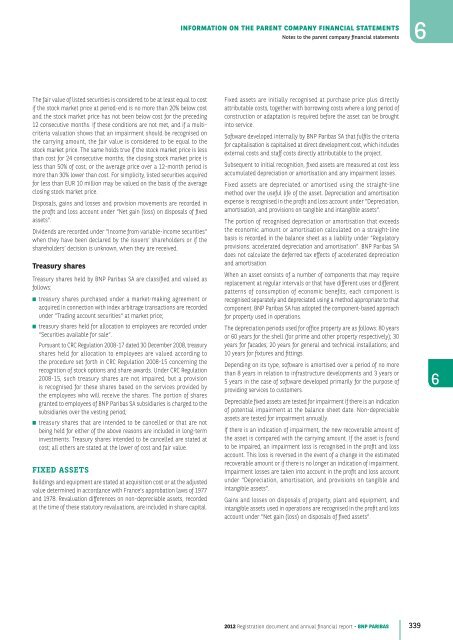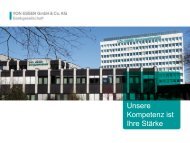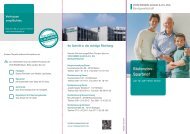2012 Registration document and annual financial report - BNP Paribas
2012 Registration document and annual financial report - BNP Paribas
2012 Registration document and annual financial report - BNP Paribas
- No tags were found...
You also want an ePaper? Increase the reach of your titles
YUMPU automatically turns print PDFs into web optimized ePapers that Google loves.
INFORMATION ON THE PARENT COMPANY FINANCIAL STATEMENTSNotes to the parent company <strong>financial</strong> statements6The fair value of listed securities is considered to be at least equal to costif the stock market price at period-end is no more than 20% below cost<strong>and</strong> the stock market price has not been below cost for the preceding12 consecutive months. If these conditions are not met, <strong>and</strong> if a multicriteriavaluation shows that an impairment should be recognised onthe carrying amount, the fair value is considered to be equal to thestock market price. The same holds true if the stock market price is lessthan cost for 24 consecutive months, the closing stock market price isless than 50% of cost, or the average price over a 12-month period ismore than 30% lower than cost. For simplicity, listed securities acquiredfor less than EUR 10 million may be valued on the basis of the averageclosing stock market price.Disposals, gains <strong>and</strong> losses <strong>and</strong> provision movements are recorded inthe profit <strong>and</strong> loss account under “Net gain (loss) on disposals of fixedassets”.Dividends are recorded under “Income from variable-income securities”when they have been declared by the issuers’ shareholders or if theshareholders’ decision is unknown, when they are received.Treasury sharesTreasury shares held by <strong>BNP</strong> <strong>Paribas</strong> SA are classified <strong>and</strong> valued asfollows:■ treasury shares purchased under a market-making agreement oracquired in connection with index arbitrage transactions are recordedunder “Trading account securities“ at market price;■ treasury shares held for allocation to employees are recorded under“Securities available for sale“.Pursuant to CRC Regulation 2008-17 dated 30 December 2008, treasuryshares held for allocation to employees are valued according tothe procedure set forth in CRC Regulation 2008-15 concerning therecognition of stock options <strong>and</strong> share awards. Under CRC Regulation2008-15, such treasury shares are not impaired, but a provisionis recognised for these shares based on the services provided bythe employees who will receive the shares. The portion of sharesgranted to employees of <strong>BNP</strong> <strong>Paribas</strong> SA subsidiaries is charged to thesubsidiaries over the vesting period;■ treasury shares that are intended to be cancelled or that are notbeing held for either of the above reasons are included in long-terminvestments. Treasury shares intended to be cancelled are stated atcost; all others are stated at the lower of cost <strong>and</strong> fair value.FIXED ASSETSBuildings <strong>and</strong> equipment are stated at acquisition cost or at the adjustedvalue determined in accordance with France’s approbation laws of 1977<strong>and</strong> 1978. Revaluation differences on non-depreciable assets, recordedat the time of these statutory revaluations, are included in share capital.Fixed assets are initially recognised at purchase price plus directlyattributable costs, together with borrowing costs where a long period ofconstruction or adaptation is required before the asset can be broughtinto service.Software developed internally by <strong>BNP</strong> <strong>Paribas</strong> SA that fulfils the criteriafor capitalisation is capitalised at direct development cost, which includesexternal costs <strong>and</strong> staff costs directly attributable to the project.Subsequent to initial recognition, fixed assets are measured at cost lessaccumulated depreciation or amortisation <strong>and</strong> any impairment losses.Fixed assets are depreciated or amortised using the straight-linemethod over the useful life of the asset. Depreciation <strong>and</strong> amortisationexpense is recognised in the profit <strong>and</strong> loss account under “Depreciation,amortisation, <strong>and</strong> provisions on tangible <strong>and</strong> intangible assets“.The portion of recognised depreciation or amortisation that exceedsthe economic amount or amortisation calculated on a straight-linebasis is recorded in the balance sheet as a liability under “Regulatoryprovisions: accelerated depreciation <strong>and</strong> amortisation“. <strong>BNP</strong> <strong>Paribas</strong> SAdoes not calculate the deferred tax effects of accelerated depreciation<strong>and</strong> amortisation.When an asset consists of a number of components that may requirereplacement at regular intervals or that have different uses or differentpatterns of consumption of economic benefits, each component isrecognised separately <strong>and</strong> depreciated using a method appropriate to thatcomponent. <strong>BNP</strong> <strong>Paribas</strong> SA has adopted the component-based approachfor property used in operations.The depreciation periods used for office property are as follows: 80 yearsor 60 years for the shell (for prime <strong>and</strong> other property respectively); 30years for facades; 20 years for general <strong>and</strong> technical installations; <strong>and</strong>10 years for fixtures <strong>and</strong> fittings.Depending on its type, software is amortised over a period of no morethan 8 years in relation to infrastructure developments <strong>and</strong> 3 years or5 years in the case of software developed primarily for the purpose ofproviding services to customers.Depreciable fixed assets are tested for impairment if there is an indicationof potential impairment at the balance sheet date. Non-depreciableassets are tested for impairment <strong>annual</strong>ly.If there is an indication of impairment, the new recoverable amount ofthe asset is compared with the carrying amount. If the asset is foundto be impaired, an impairment loss is recognised in the profit <strong>and</strong> lossaccount. This loss is reversed in the event of a change in the estimatedrecoverable amount or if there is no longer an indication of impairment.Impairment losses are taken into account in the profit <strong>and</strong> loss accountunder “Depreciation, amortisation, <strong>and</strong> provisions on tangible <strong>and</strong>intangible assets“.Gains <strong>and</strong> losses on disposals of property, plant <strong>and</strong> equipment, <strong>and</strong>intangible assets used in operations are recognised in the profit <strong>and</strong> lossaccount under “Net gain (loss) on disposals of fixed assets“.6<strong>2012</strong> <strong>Registration</strong> <strong>document</strong> <strong>and</strong> <strong>annual</strong> <strong>financial</strong> <strong>report</strong> - <strong>BNP</strong> PARIBAS 339





